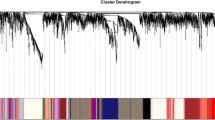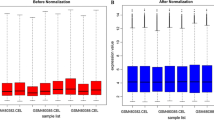Abstract
Myocardial infarction (MI) is a serious heart disease. The cardiac cells of patients with MI will die due to lack of blood for a long time. In this study, we aimed to find new targets for MI diagnosis and therapy. We downloaded GSE22229 including 12 blood samples from healthy persons and GSE29111 from Gene Expression Omnibus including 36 blood samples from MI patients. Then we identified differentially expressed genes (DEGs) in patients with MI compared to normal controls with p value < 0.05 and |logFC| > 1. Furthermore, interaction network and sub-network of these of these DEGs were constructed by NetBox. Linker genes were screened in the Global Network database. The degree of linker genes were calculated by igraph package in R language. Gene ontology and kyoto encyclopedia of genes and genomes pathway analysis were performed for DEGs and network modules. A total of 246 DEGs were identified in MI, which were enriched in the immune response. In the interaction network, LCK, CD247, CD3D, FYN, HLA-DRA, IL2, CD8A CD3E, CD4, CD3G had high degree, among which CD3E, CD4, CD3G were DEGs while others were linker genes screened from Global Network database. Genes in the sub-network were also enriched in the immune response pathway. The genes with high degree may be biomarkers for MI diagnosis and therapy.



Similar content being viewed by others
References
Benowitz NL, Prochaska JJ (2013) Smoking cessation after acute myocardial infarction. J Am Coll Cardiol 61:533–535
Davis TM, Coleman RL, Holman RR (2013) Prognostic significance of silent myocardial infarction in newly diagnosed type 2 diabetes mellitus clinical perspective United Kingdom Prospective Diabetes Study (UKPDS) 79. Circulation 127:980–987
Peter S, Hulme O, Deuse T, Vrtovec B, Fearon W, Hunt S, Haddad F (2013) ST-elevation myocardial infarction following heart transplantation as an unusual presentation of coronary allograft vasculopathy: a case report. In: Transplantation proceedings. Elsevier, New York
Helgadottir A, Manolescu A, Thorleifsson G, Gretarsdottir S, Jonsdottir H, Thorsteinsdottir U, Samani NJ, Gudmundsson G, Grant SF, Thorgeirsson G (2004) The gene encoding 5-lipoxygenase activating protein confers risk of myocardial infarction and stroke. Nat Genet 36:233–239
Nio Y, Matsubara H, Murasawa S, Kanasaki M, Inada M (1995) Regulation of gene transcription of angiotensin II receptor subtypes in myocardial infarction. J Clin Invest 95:46
Tao Z, Chen B, Tan X, Zhao Y, Wang L, Zhu T, Cao K, Yang Z, Kan YW, Su H (2011) Coexpression of VEGF and angiopoietin-1 promotes angiogenesis and cardiomyocyte proliferation reduces apoptosis in porcine myocardial infarction (MI) heart. Proc Natl Acad Sci 108:2064–2069
Aggarwal S, Ghilardi N, Xie M-H, De Sauvage FJ, Gurney AL (2003) Interleukin-23 promotes a distinct CD4 T cell activation state characterized by the production of interleukin-17. J Biol Chem 278:1910–1914
Stanton LW, Garrard LJ, Damm D, Garrick BL, Lam A, Kapoun AM, Zheng Q, Protter AA, Schreiner GF, White RT (2000) Altered patterns of gene expression in response to myocardial infarction. Circ Res 86:939–945
Alpert J, Thygesen K, Antman E, Bassand J (2000) Myocardial infarction redefined—a consensus document of the Joint European Society of Cardiology/American College of Cardiology Committee for the Redefinition of Myocardial Infarction. J Am Coll Cardiol 36:959–969
Newell KA, Asare A, Kirk AD, Gisler TD, Bourcier K, Suthanthiran M, Burlingham WJ, Marks WH, Sanz I, Lechler RI (2010) Identification of a B cell signature associated with renal transplant tolerance in humans. J Clin Invest 120:1836
Gentleman RC, Carey VJ, Bates DM, Bolstad B, Dettling M, Dudoit S, Ellis B, Gautier L, Ge Y, Gentry J (2004) Bioconductor: open software development for computational biology and bioinformatics. Genome Biol 5:R80
Sanges R, Cordero F, Calogero RA (2007) oneChannelGUI: a graphical interface to Bioconductor tools, designed for life scientists who are not familiar with R language. Bioinformatics 23:3406–3408
Yu G, Wang L-G, Han Y, He Q-Y (2012) clusterProfiler: an R package for comparing biological themes among gene clusters. Omics 16:284–287
Cerami E, Demir E, Schultz N, Taylor BS, Sander C (2010) Automated network analysis identifies core pathways in glioblastoma. PLoS ONE 5:e8918
Shannon P, Markiel A, Ozier O, Baliga NS, Wang JT, Ramage D, Amin N, Schwikowski B, Ideker T (2003) Cytoscape: a software environment for integrated models of biomolecular interaction networks. Genome Res 13:2498–2504
Csardi G, Nepusz T (2006) The igraph software package for complex network research. InterJournal, Complex Systems 1695
Haeusler KG, Schmidt WU, Foehring F, Meisel C, Guenther C, Brunecker P, Kunze C, Helms T, Dirnagl U, Volk H-D (2012) Immune responses after acute ischemic stroke or myocardial infarction. Int J Cardiol 155:372–377
Syriga M, Mavroidis M (2013) Complement system activation in cardiac and skeletal muscle pathology: friend or foe? In: Lambris JD, Holers VM, Ricklin D (eds) Complement therapeutics. Springer, New York, pp 207–218
Zouggari Y, Ait-Oufella H, Bonnin P, Simon T, Sage AP, Guérin C, Vilar J, Caligiuri G, Tsiantoulas D, Laurans L (2013) B lymphocytes trigger monocyte mobilization and impair heart function after acute myocardial infarction. Nat Med 19:1273–1280
Frantz S, Hofmann U, Fraccarollo D, Schäfer A, Kranepuhl S, Hagedorn I, Nieswandt B, Nahrendorf M, Wagner H, Bayer B (2013) Monocytes/macrophages prevent healing defects and left ventricular thrombus formation after myocardial infarction. FASEB J 27:871–881
Charo IF (2013) Blinding the monocytes to protect the heart. Circulation 127:2006–2008
Tunnacliffe A, Olsson C, De La Hera A (1989) The majority of human CD3 epitopes are conferred by the epsilon chain. Int Immunol 1:546–550
Sancho D, Joffre OP, Keller AM, Rogers NC, Martínez D, Hernanz-Falcón P, Rosewell I, E Sousa CR (2009) Identification of a dendritic cell receptor that couples sensing of necrosis to immunity. Nature 458:899–903
Wang M, Windgassen D, Papoutsakis ET (2008) Comparative analysis of transcriptional profiling of CD3+, CD4+ and CD8+ T cells identifies novel immune response players in T-cell activation. BMC Genom 9:225
Park C-I, Hirono I, Enomoto J, Nam B-H, Aoki T (2001) Cloning of Japanese flounder Paralichthys olivaceus CD3 cDNA and gene, and analysis of its expression. Immunogenetics 53:130–135
Hosono M, De Boer OJ, Van Der Wal AC, Van Der Loos CM, Teeling P, Piek JJ, Ueda M, Becker AE (2003) Increased expression of T cell activation markers (CD25, CD26, CD40L and CD69) in atherectomy specimens of patients with unstable angina and acute myocardial infarction. Atherosclerosis 168:73–80
Swanberg M, Lidman O, Padyukov L, Eriksson P, Åkesson E, Jagodic M, Lobell A, Khademi M, Börjesson O, Lindgren CM (2005) MHC2TA is associated with differential MHC molecule expression and susceptibility to rheumatoid arthritis, multiple sclerosis and myocardial infarction. Nat Genet 37:486–494
Doyle C, Strominger JL (1987) Interaction between CD4 and class II MHC molecules mediates cell adhesion. Nature 330(6145):256–259
Gordts S, Muthuramu I, Nefyodova E, Jacobs F, Van Craeyveld E, De Geest B (2013) Beneficial effects of selective HDL-raising gene transfer on survival, cardiac remodelling and cardiac function after myocardial infarction in mice. Gene Ther 20:1053–1061
Sam F, Sawyer DB, Chang DL-F, Eberli FR, Ngoy S, Jain M, Amin J, Apstein CS, Colucci WS (2000) Progressive left ventricular remodeling and apoptosis late after myocardial infarction in mouse heart. Am J Physiol Heart Circ Physiol 279:H422–H428
Liu P, Aitken K, Kong Y-Y, Opavsky MA, Martino T, Dawood F, Wen W-H, Kozieradzki I, Bachmaier K, Straus D (2000) The tyrosine kinase p56lck is essential in coxsackievirus B3-mediated heart disease. Nat Med 6:429–434
Blum A, Sclarovsky S, Rehavia E, Shohat B (1994) Levels of T-lymphocyte subpopulations, interleukin-1β, and soluble interleukin-2 receptor in acute myocardial infarction. Am Heart J 127:1226–1230
Shimpo M, Morrow DA, Weinberg EO, Sabatine MS, Murphy SA, Antman EM, Lee RT (2004) Serum levels of the interleukin-1 receptor family member ST2 predict mortality and clinical outcome in acute myocardial infarction. Circulation 109:2186–2190
Kuijpers TW, Van Leeuwen EM, Barendregt BH, Klarenbeek P, Daan J, Baars PA, Jansen MH, De Vries N, Van Lier RA, Van Der Burg M (2013) A reversion of an IL2RG mutation in combined immunodeficiency providing competitive advantage to the majority of CD8+ T cells. Haematologica 98(7):1030–1038
Acknowledgments
The fund of the Provincial Health Department of Heilongjiang Province (project number 2011-170). The Science and Technology Youth foundation of Heilongjiang Province (project number QC2012C129). The fund of the Administration of Traditional Chinese Medicine of Heilongjiang Province (project number ZHY12-Z148). We wish to express our warm thanks to Fenghe (Shanghai) Information Technology Co., Ltd. Their ideas and help gave a valuable added dimension to our research.
Conflict of interest
All authors declare that they have no conflict of interest.
Author information
Authors and Affiliations
Corresponding author
Rights and permissions
About this article
Cite this article
Zhang, T., Zhao, LL., Zhang, ZR. et al. Interaction network analysis revealed biomarkers in myocardial infarction. Mol Biol Rep 41, 4997–5003 (2014). https://doi.org/10.1007/s11033-014-3366-4
Received:
Accepted:
Published:
Issue Date:
DOI: https://doi.org/10.1007/s11033-014-3366-4




